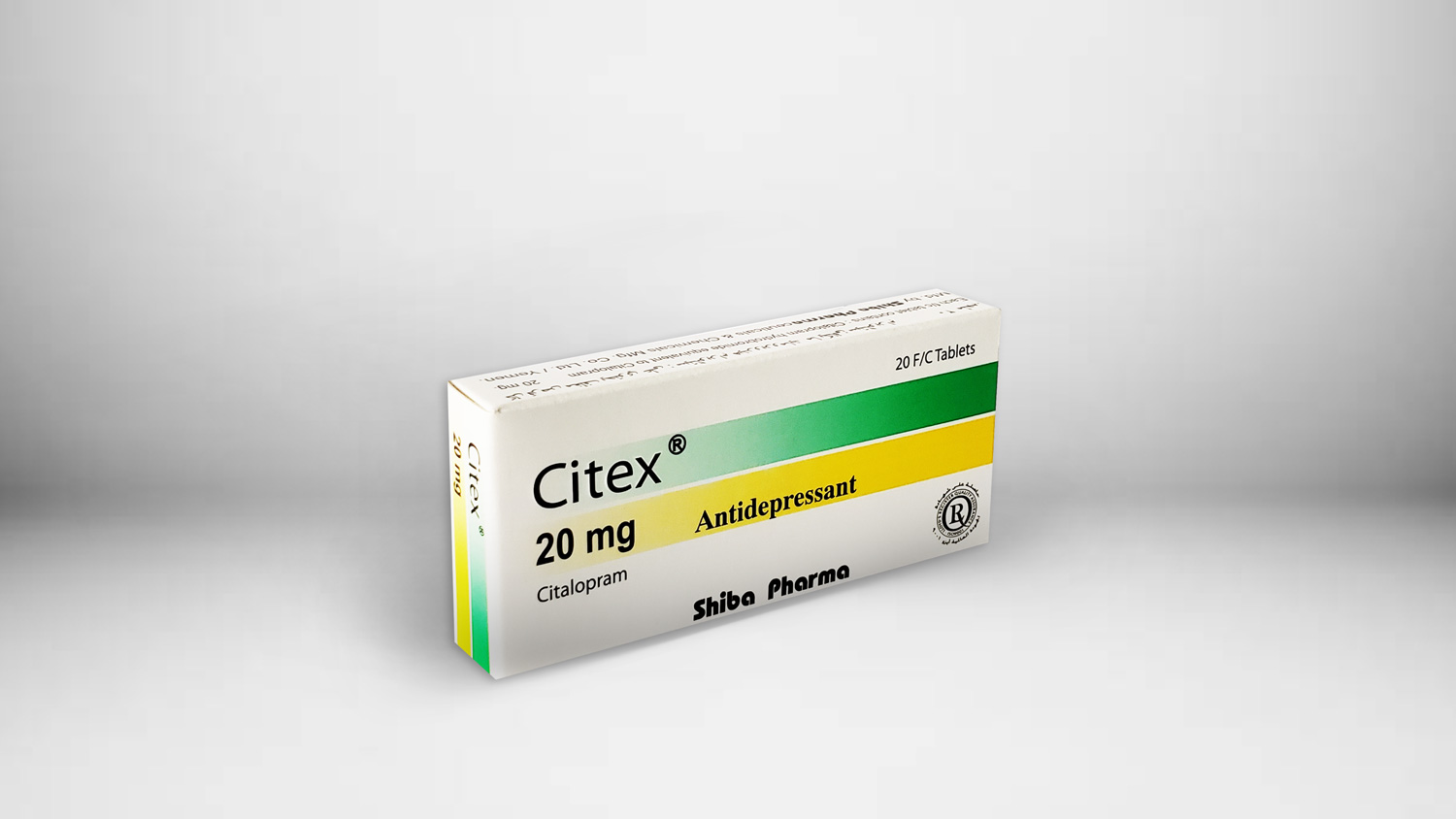Section :
Citex
COMPOSITION :
Each f/c tablet contains : Citalopram Hydrobromide USP equivalent to Citalopram 20 mg.
DESCRIPTION :
Citex 20 (Citalopram) is an antidepressant drug. It is the most Selective Serotonin Reuptake Inhibitor (SSRI). It acts by prevention of the reuptake of monoamine transmitters such as serotonin, which potentiates their action in the brain. Citex 20 is readily absorbed from the gastrointestinal tract and the maximum plasma concentration is reached 2 - 4 hours after oral doses. It is widely distributed throughout the body and less than
80% binding with plasma protein. Citalopram is metabolised to active and inactive metabolites and the elimination half life is about 36 hours. It is excreted mainly via the liver (85%) and the remainder via the kidneys.
INDICATIONS :
Citex 20 is used for treatment of :
- Depression.
- Panic disorder with or without agoraphobia.
- Obsessive - Compulsive Disorder (OCD).
DOSAGE AND ADMINISTRATION :
Citex 20 is taken every day as a single dose with or without food and swallow with water.
- Adults :
• In case of Depression : The initial dose is 20 mg (one tablet) daily , after at least one week and depending on patient response , the dose may be increased to a maximum of 40 mg (2 tablets).
• In case of Panic disorder : The initial dose is 10 mg (1/2 tablet) daily for first week before increasing the dose to 20 mg (one tablet). Depending on patient response, the dose may be increased to a maximum of
40 mg (2 tablets).
• In case of Obsessive-Compulsive Disorder : The initial dose is 20 mg (one tablet) daily, after at least one week and depending on patient response , the dose may be increased to a maximum of 40 mg (2 tablets).
- Elderly patients (above 65 years of age) :
The dose should be decreased to half of the recommended dose (10-20 mg) daily. The recommeded maximum dose for the elderly is 20 mg (one tablet).
- Hepatic impairment patients :
An initial dose of 10 mg (1/2 tablet) daily for the first two weeks of the treatment is recommended in patients with mild to moderate hepatic impairment , depending on patient response , the dose may be increased to a maximum of 20 mg(one tablet).
Caution and extra careful dose is advised in patients with severely reduced hepatic function.
- Renal impairment patients :
There is no need for dose adjustment in mild to moderate renal impairment although information is lacking on appropriate dosage in severe renal impairment (Creatinin Clearance < 20 ml/min).
- Children and adolescents (<18 years)
Citalopram is not given to children and adolescents less than 18 years.
RESTRICTIONS ON USE :
Contraindications
- Known hypersensitivity to Citalopram.
- Taking monoamine oxidase inhibitors (MAOIs) at the same time with Citalopram.
- Concomitant administration of Citalopram with pimozide or any other drug that prolongs the Q.T. interval.
Precautions
- Citalopram should be used with caution in patients with :
• Epilepsy or a history of such disorders (Treatment should be avoided if the epilepsy is poorly controlled and the treatment should be stopped if seizures develop or when there is an increase in frequency).
• Cardiac diseases or a history of bleeding disorders.
• Diabetes or narrow angle-closure glaucoma or history of glaucoma.
• Severe liver or renal impairment.
• Depression , because suicide is an inherent risk in depressed patients. So pateints should be closely monitored during early therapy until significant improvement is observed.
- Citalopram should be withdrawn gradually to reduce the risk of withdrawal symptoms during dosage reduction or stopping treatment . Withdrawal common symptoms include dizziness , numbness , tingling , gastro-intestinal disturbances (nausea and vomiting) , headache , sweating , anxiety , sleeping disorders , emotional instability , irritability and visual disturbances.
- If the depressed patient develop akathisia symptoms, increasing the dose of Citalopram may be determinate.
- If the patient with manic-depressive illness change towards the manic phase , Citalopram should be discontinued.
- Drink of alcohol should be avoided.
Effects on the capacity to drive vehicles or use machines
Generally, Citalopram does not cause drowsiness , but if the patient feels dizzy or sleepy when starts taking the medicine , he should avoid driving vehicles or using machines.
Use in Pregnancy & Lactation
Citalopram should not be taken by pregnant women and breast-feeding mothers.
DRUG INTERACTIONS :
- Occasionally , Citalopram has been associated with bleeding disorders and other effects on the blood , caution is advised when it is given with drugs known to affect platelets function (eg. some antipsychotic drugs , triycyclic antidepressants , acetylsalicytic acid , non-steroidal anti-inflammatory drugs).
- Using of Citalopram with other antidepressants may lead to severe adverse reactions including the serotonin syndrome .
- Citalopram should be used with caution with lithium and tryptophan.
- The dose of selegiline must not exceed 10 mg daily if used with citalopram (20 mg daily).
- The blood levels of metoprolol are increased when used with Citalopram.
- Use of Citalopram with sumatriptan may increase the risk of side effects.
- Citalopram blood levels may be moderately increased when used with high doses of cimetidine.
- At least one week should be elapsed between withdrawing Citalopram and starting any drug liable to provoke a serious reaction (as phenelzine).
- Concomitant intake of St. John wort (hypericum perforatum) with Citalopram may increase the risk of side effects.
SIDE EFFECTS :
- The following side effects are often mild and usually disappear after few day’s treatment :
• Common side effects : Dry mouth , increased sweating , agitation , decreased appetite , sleeplessness ,
feeling sleep , yawning , diarrhoea , nausea , fatigue and decreased sex drive.
• Very rare side effects : Hypersensitivity (rash) , seizures , cutaneous bleeding disorder and unusual muscle movement or stiffness.
- The following side effects are very rare but serious and if they appear , the doctor should be consulted immediately :
• Signs of hyponatraemia as feeling sick and unwell with weak muscles or confused.
• Signs of serotonin syndrome as high fever , agitation, confusion , trembling and abrupt contractions of muscles.
OVERDOSE :
Symptoms of overdose may include : nausea , vomiting , sweating , drowsiness , blue discoloration of the skin , seizures , unconsciousness , fast heart beats , ECG abnormalities , tremor and serotonin syndrome . There is no specific antidote to Citalopram , but the treatment of overdose involves appropriate symptomatic and supportive therapy including the maintenance of clear airways and monitoring of ECG and vital signs until stable. Activated charcoal may be given by mouth to adults and children if the amount ingested was large (5 mg/kg) and treatment is within an hour of Citalopram ingestion. Osmotically working laxative (as sodium sulphate) and stomach evacuation should be considered . If consciousness is impaired , the patient should be intubated. Control
frequent or prolonged convulsions with intravenous diazepam .
STORAGE INSTRUCTIONS :
Store below 30° C in a dry place.
PRESENTATION :
Citex 20 : Pack of 20 tablets and hospital packs of different sizes.


